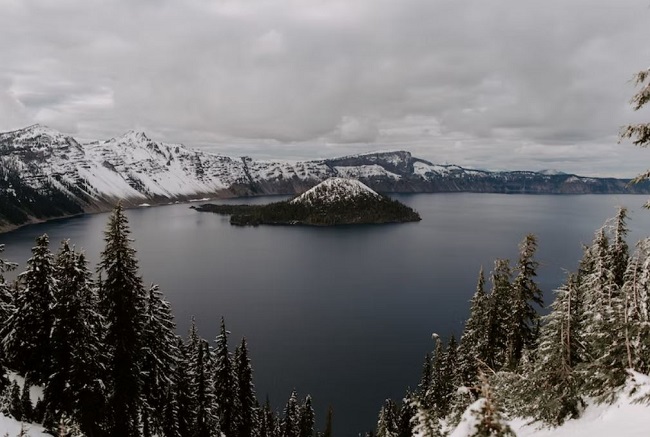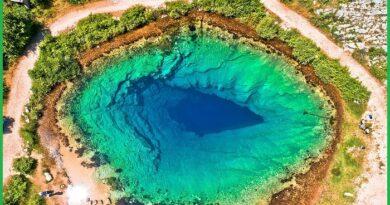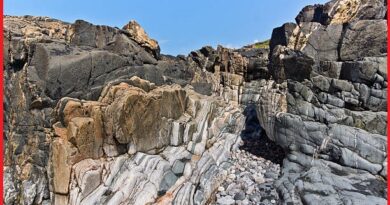Arizona Crater National Park-A Gigantic Impact crater in Arizona desert
Arizona Crater
The Barringer Meteorite Crater or simply meteor crater is a gigantic hole in the middle of the arid sandstone of the Arizona desert. A rim of smashed and jumbled boulders, the size of small houses, rises 50 meters above the surrounding plain. The crater itself is nearly 1500 meters wide and 180 meters deep. At the time of its discovery, the plain around it was covered with chunks of meteoritic iron. Nearly 30 tons of iron scattered over an area 12 kilometers to 15 kilometers in diameter. Research says that the Arizona crater was created approximately 50,000 years ago. The meteorite that hits the earth was composed of nickel-iron, suggesting that it may have originated in the interior of a small planet. The Meteorite was 50 meters across and weighed roughly 300,000 tons, and traveled at a speed of 65,000 kilometers per hour. Most asteroids that hit the Earth’s atmosphere ultimately plummet into the water, because oceans cover 70 percent of the planet. But massive space rocks occasionally hit land. This iron asteroid also smashed into North America and left a gaping hole in what is today northern Arizona.

Geography Arizona Crater
Meteor Crater is located between Flagstaff and Winslow on the Colorado Plateau. Meteor crater, Arizona age-The crater is created 50,000 years back during the Pleistocene epoch and is relatively young and remarkably well-preserved compared to other craters. Because of this, scientists learn about this site extensively to know the cratering processes, and how they work on Earth and elsewhere in the solar system. A similar-sized impact event today could destroy a city the size of Kansas City.
Also, read- Mauritius Island-A 8 million years Old Volcanic Island
The mammoths and other giant land creatures of the last ice age were not in the surrounding when the incident happen everything was destroyed in the area around the impact for miles. Shock waves moved through the ground like an earthquake for a greater distance. The rocks which had been flat layers before the impact was thrown up to form the rim and shattered. For a very long time immediately after the impact, the crater was a lake. There are 27 m of lake deposits on the floor of the crater today. From a distance, the Arizona Meteor Crater looks like nothing more than a low ridge. When one climbs the slope and reaches the top of the rim the great chasm is revealed.

Meteor Crater History- In 1902 Daniel Moreau Barringer forms the Standard Iron Company in Philadelphia with the intent of locating and mining the buried deposit of nickel-iron. Barringer has never been to the crater. He has acquired a patent here to mine the sites. In March of 1904 Barringer and his partner Benjamin C. Tilghman arrive at the crater for the first time. Barringer excavated millions of tons of nickel-iron under the crater floor. His Company begins the exploration with a hand-dug shaft and Meteor Crater was easy to dig very soon the shaft reaches 55 m in depth.
Geology
The impact created an inverted stratigraphy that the layers immediately exterior to the rim are stacked in the reverse order in which they normally occur. The impact overturned and inverted the layers to a distance of 1–2 km outward from the crater’s edge. When climbing the rim of the crater from the outside, one finds:
Coconino Sandstone (265 million years) nearest the top of the rim
Toroweap Formation (a limestone formed 255 million years ago)
Kaibab Formation (dolostone formed 250 million years ago)
Moenkopi Formation (mudstone formed 245 million years ago) nearest the outer foot of the rim
Soils around the crater are brown, slightly to moderately alkaline, gravelly, or stony loam of the Winona series.
Meteor Crater, Arizona Tour
The Arizona Crater is a famous tourist attraction in Arizona with a museum featuring the history of the crater and asteroid impact science. Meteor Crater, AZ is also a wonderful laboratory for research by scientists who come from all over the world. In order to preserve the site for future generations there is no hiking of the crater rim allowed. There is a guided hike offered when weather permits that is informative and enjoyable. The Meteor Crater Rim Tour shows the important features and sights along the rim of the Meteor Crater.

Arizona crater national park
Arizona crater national park is the world’s best-preserved meteorite impact site on Earth. It is located near minutes from Interstate 40 and the old Route 66 in Northern Arizona near Winslow. Situated under the wide skies of the Arizona High Desert, Meteor Crater offers an interactive educational experience for the entire family. Stop at the Meteor Crater Visitor Center located on the rim of the Crater, where the fully air-conditioned building features an 80-seat widescreen theater and viewing area, Crater Trail access, Interactive Discovery Center and artifacts. Visitors can plan a day trip from Flagstaff to Sunset Crater Volcano National Monument.
Arizona crater lake
Crater Lake is one of the deepest lakes in the USA and one of the most pristine on Earth. Artists, photographers, and sightseers gaze in wonder at its blue water and stunning setting atop the Cascade Mountain Range. A massive volcanic eruption occurred about 7,700 years ago. It was followed by ejections of volcanic matter through fractures, in an oval shape around the mountain. Over the years the events weakened the mountain’s structure and the central portion of Mount Mazama to collapse inward. The result was an 8–10 km diameter and 1.2 km deep caldera. Before the collapse, Mount Mazama loomed at approximately 3,658 m tall. This Caledra today is the Crater Lake with an average of 31 m deep. Crater Lake is the deepest lake in the United States. It is one of the top ten deepest in the world.

How to Reach Arizona Crater
The world’s best-preserved meteorite impact site is tucked just a few miles off I-40 & the historic Route 66 in Northern Arizona, about 40 minutes east of Flagstaff.




Pingback: Mount St. Helens- An Active Volcano Trail And Hiking Destination USA - Geotourism